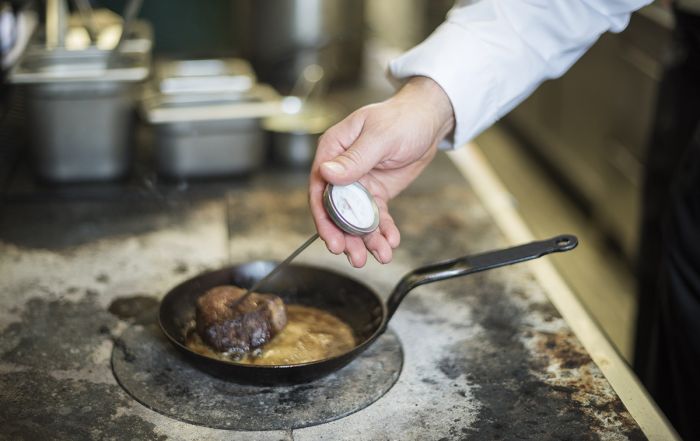Auditing Glove Use
Most food workers know the basics of glove use, but the real question is “What do they actually do?” We recommend that managers/supervisors take time to audit glove use practices in their operation. This is a way to check that staff are doing what they are supposed to be doing to keep the food safe by using gloves correctly.
FoodHandler® has a glove audit form on their website that you could use for making these observations. This form could be used on a quarterly basis to document the good behaviors (catch people doing things right!) and to identify corrective actions needed.
Audit Managerial Practices
The first step is to make sure employees have the tools they need. Start by checking whether or not you are providing the gloves that workers need. Ask yourself:
- Are there appropriate sizes of gloves available for your staff?
- Is there more than one type of glove available (nitrile, vinyl, etc.)? Some employees may have sensitivities to one type of glove, but not to another. Also, there are more and more states banning the use of latex gloves in foodservice because of latex allergies.
- Are gloves located in the work stations where needed? Make it easy for food workers to follow the standard operating procedures for glove use.
- Is there a glove dispensing system that protects gloves from contamination? These systems are convenient and cost effective, and they reduce opportunities for gloves to become contaminated. Check out our FoodHandler OneSafe® dispensers if you haven’t already.
Audit Employee Glove Use Practices
Now you can observe food workers in their daily activities to determine actual glove-use practices. Pick a typical day of operations. If you plan to compare audits over time, then choose a consistent day with the same menu. There are a few other suggestions for use of the audit on the form. General observation points include:
- Are employees always wearing gloves when handling ready-to-eat foods?
- Are they changing gloves between tasks?
- Are new gloves being used when returning to work stations?
- Are gloves always worn over bandages on hands?
- Are gloves changed at least once every four hours if one continuous task is being performed?
- Are workers washing hands properly before putting on gloves?
- Are gloves removed from the dispenser one at a time?
- Are gloves handled only by the cuff?
- Are gloves removed from hands and boxes properly to minimize contamination?
New employees need to be trained on expectations for glove use. Managers can make observations of glove use on a continual basis and make adjustments as needed. Some staff may need reminders of proper use or a manager may discover certain types or sizes of gloves are used more frequently. Managers can use this information as a performance indicator (see our blog in May with some tools about KPIs or key performance indicators). Management by walking around lets you as the person in charge know what is really happening in your operations. Risk Nothing!

READ MORE POSTS
UNDERSTANDING TIME AS A CONTROL FOR PUBLIC HEALTH
Much of our business that revolves around food safety is governed by temperatures. The endpoint cooking [...]
RETHINKING THE RINSE: WHY WASHING POULTRY ISN’T SO WISE
As November rolls around, we generally start to shift our focus to Thanksgiving and the busy [...]
Navigating the Intricacies of Temperature Management
I spend a bit of time in these blogs discussing various nuances of food safety – [...]
IN AN AI WORLD, ENSURE YOUR FOOD SAFETY FUNDAMENTALS ARE ESTABLISHED
In October, I talked about how you could use artificial intelligence (AI) to enhance your food safety [...]










